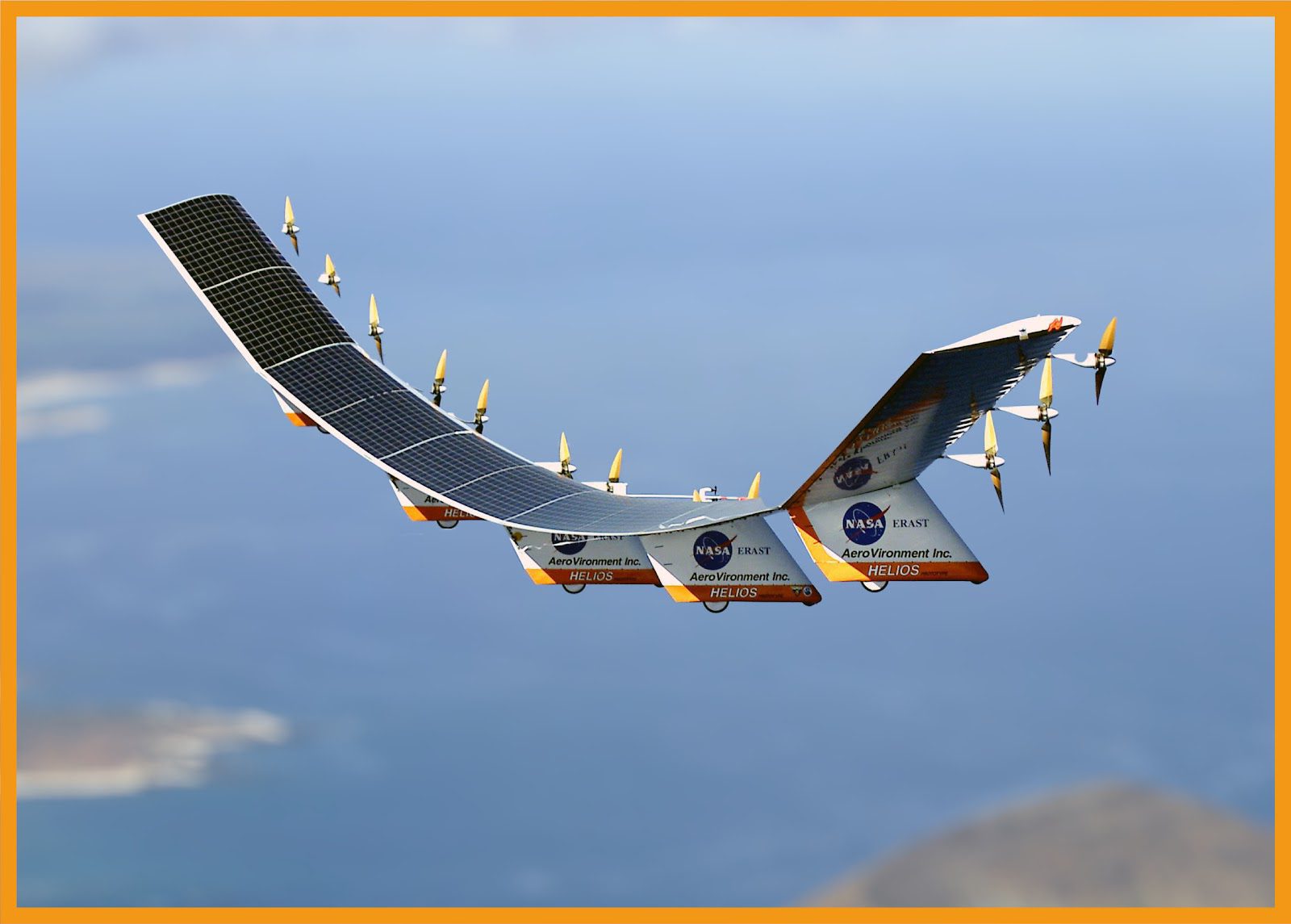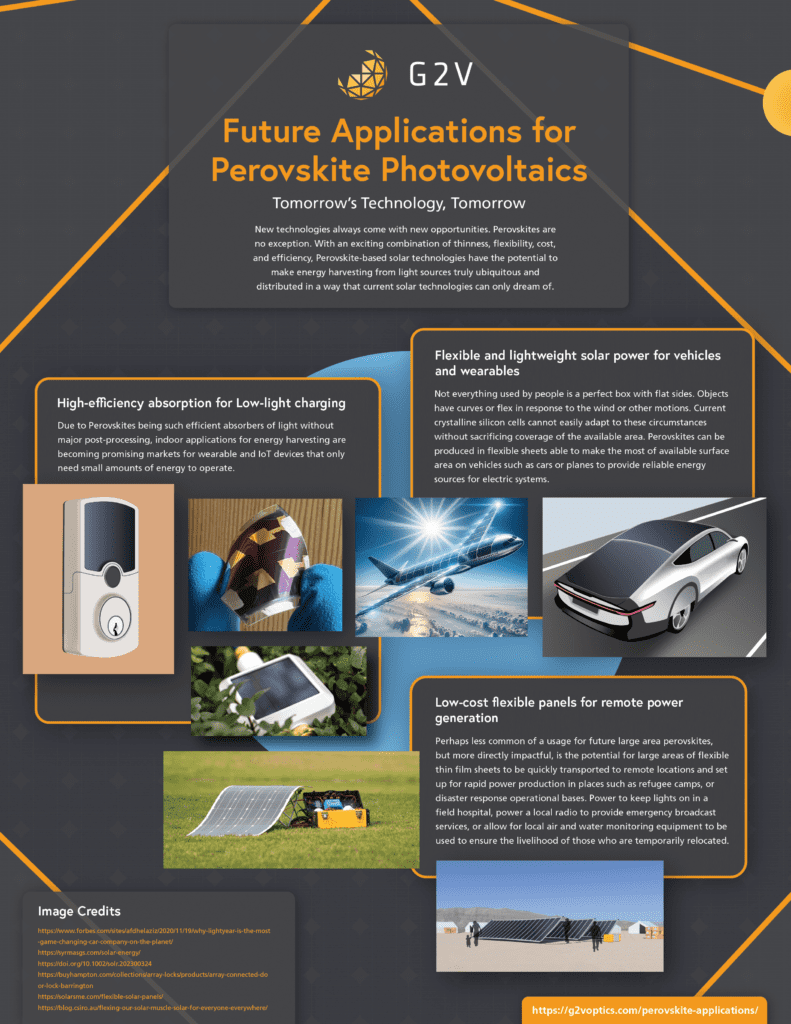Chapter 9
What Applications Exist For Perovskite Solar Cells In The Near Future?
Over the last eight chapters, we’ve discussed the history, construction, capabilities, potential problems, and test practices of perovskite solar technologies. So, where are people thinking of applying perovskite solar cell technology next?
One possible application is the replacement of current large-scale panels in residential and commercial energy production. However, what less obvious options are unlocked due to some of the unique characteristics of perovskites not shared by current commercial solar technologies?
Lightweight Perovskite Films And The Vehicles They Enable (VIPV)
For stationary solar devices, weight and flexibility are not primary considerations beyond potential compliance with standards.
With the reduced weight and higher flexibility brought on by the thin film perovskite construction, opportunities for integrated solar power in vehicular platforms are no longer seeming out of the realm of possibility for the mass market.
For some possible specialty applications, such as climate monitoring or long-duration observation of remote locations for ecological or national-interest purposes, the idea of a solar-powered drone, something not considered viable with traditional silicon solar cells, is very attractive.

Even simpler, the use of perovskites as a method of range extension for less specialized battery electric vehicles (BEVs), called Vehicle Integrated PV (VIPV), ranging in size from e-bikes and cars to private planes, is under consideration.
With the ability to apply thin films to curved surfaces without the weight of thicker silicon panels, the amount of surface that can be covered by these devices is maximized while minimizing the amount of energy spent moving that weight.
Sadly, a fully solar-powered vehicle with “infinite range” for consumers is likely to be a fairly niche application, barring significant improvements to energy storage technologies. A built-for-purpose vehicle might be able to supply enough power, but given the generally low surface area available for solar cell integration even with flexible thin films, the use of thin-film integrated solar cells on BEVs is looking to be limited to a method of range extension rather than a sole power source.

Applications For Perovskite Integration Into Commercial Infrastructure
If reducing reliance on electrical infrastructure for your personal mobility isn’t enough, there is also potential for perovskites to be integrated more directly into residential and commercial building construction.
Standard roof or shingle mountings are well-known solar cell applications, and the benefits of lighter and more efficient collectors are fairly obvious, but the truly interesting application is how effective perovskites work as transparent solar panels in windows.
The idea of solar windows can seem a little counter-intuitive as windows are meant to let light through, while solar power is about capturing as much light as possible. Nevertheless, there has been research into the topic.
Some efforts focus on harvesting the non-visible portions of the spectrum (UV and IR) to allow for more normal-looking transparent windows.
The other school of thought is looking at more dual-purpose designs where shading and power generation are linked together to provide electricity while helping prevent the interior from overheating.
Reducing the need for air conditioning while also providing energy to be used in the complex itself during the hottest and thus most likely heaviest electrical demand periods can help stabilize energy usage for both large and micro-grids, and helps adapt our cities for the changing circumstances of the world.
Energy On The Go And Wherever You Are: Perovskite Wearables And the Internet of Things
The changing circumstances of the world are not merely environmental but also technological.
The drive for smaller and more integrated computer components has resulted in the dispersion of connected devices and sensors in more and more aspects of our lives. The Internet of Things (IoT), as it is called, is an exciting field full of possibilities such as the integrated examination and automation of our entire world in unprecedented fidelity.
Figuring out how to power all of those devices, especially the ones that are not able to be connected to the grid, is difficult. With high efficiency, low cost, low-light capable perovskite solar cells, the range of possible devices is expanded.
As an even more unexpected possibility, for devices that are either too small to have a battery attached, or too energy-intensive to have one last for long enough to be useful, researchers have begun incorporating perovskite solar technology into clothing.
This would work as a kind of power hub source to supply extra energy to some of the many commonly-used devices such as headphones, smartwatches, or fitness trackers.
Imagine being able to wirelessly recharge your phone just by putting it in your jacket pocket while you are out on a walk!
It could also open up options for new additions to clothing such as integrated light systems for fashion or safety, or supply a larger power budget for something like smart glasses.
Beyond the personal and into the more serious applications, there are a large number of applications where perovskites can save lives.
Disaster sites, refugee camps, and other locations where threats to people’s well-being exist are always in dire need of energy to run devices. This energy is needed both to improve conditions for residents/victims and support emergency workers during whatever operations they might find themselves undertaking in their aid.
Mobile power packs, able to charge themselves without relying solely on infrastructure that might not be in place, could mean the difference between life and death for someone.
Perovskites have incredible potential to be implemented in a wide range of important applications.
The vast scope of possible perovskite solar cell recipes, as well as the complexity of transport mechanisms, requires rapid and accurate testing. As perovskites are known to be sensitive to external factors such as heat, it is important to have methods of testing that are as controllable as possible without any excess exposure to otherwise invisible parts of the solar spectrum such as UV and infrared.
-Last Chapter-
Throughout these nine chapters, we have shown why Perovskites are an exciting field that has steadily made good on the promises discovered in research labs. With the potential to make solar energy generation ubiquitous, there is little doubt that the current small barriers to their mass adoption will be dealt with and give everyone a new reliable way to access the energy we need to improve our world.
Back to Start: Perovskite Solar Cells Technology Article – Table of Contents
Looking for a cheat sheet with all of the key concepts in this article? Check out the one-page infographic below.
Perovskites Applications for the Future Infographic:

